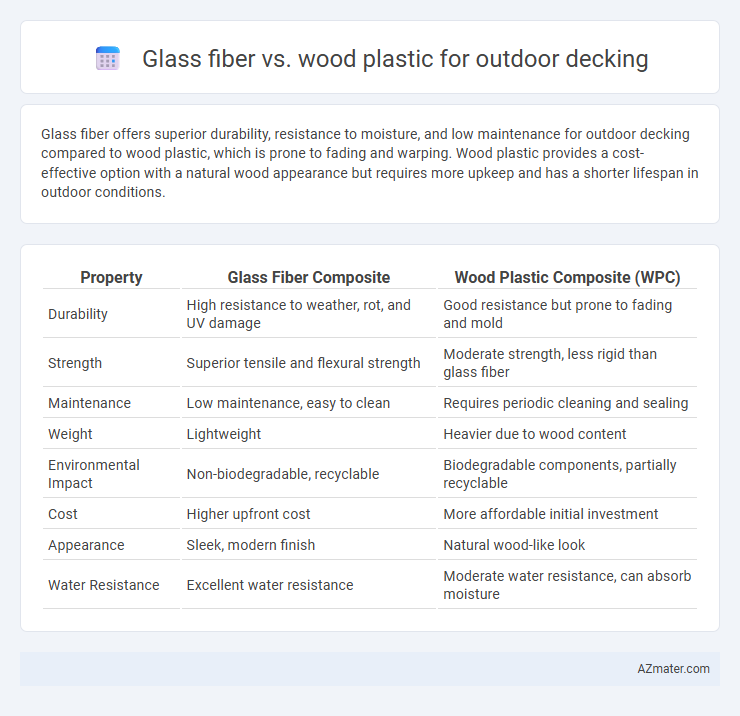Glass fiber offers superior durability, resistance to moisture, and low maintenance for outdoor decking compared to wood plastic, which is prone to fading and warping. Wood plastic provides a cost-effective option with a natural wood appearance but requires more upkeep and has a shorter lifespan in outdoor conditions.
Table of Comparison
| Property | Glass Fiber Composite | Wood Plastic Composite (WPC) |
|---|---|---|
| Durability | High resistance to weather, rot, and UV damage | Good resistance but prone to fading and mold |
| Strength | Superior tensile and flexural strength | Moderate strength, less rigid than glass fiber |
| Maintenance | Low maintenance, easy to clean | Requires periodic cleaning and sealing |
| Weight | Lightweight | Heavier due to wood content |
| Environmental Impact | Non-biodegradable, recyclable | Biodegradable components, partially recyclable |
| Cost | Higher upfront cost | More affordable initial investment |
| Appearance | Sleek, modern finish | Natural wood-like look |
| Water Resistance | Excellent water resistance | Moderate water resistance, can absorb moisture |
Introduction to Outdoor Decking Materials
Glass fiber and wood plastic composite (WPC) are popular materials for outdoor decking due to their durability and low maintenance. Glass fiber decking offers superior strength, resistance to moisture, and long-lasting performance compared to traditional wood. Wood plastic composites blend natural wood fibers with recycled plastics, providing a sustainable option that resists rot, insect damage, and weathering for outdoor environments.
What is Glass Fiber Decking?
Glass fiber decking, also known as fiberglass decking, is a composite material made from glass fibers embedded in a resin matrix, providing exceptional strength and durability. It resists moisture, rot, and insect damage far better than traditional wood or wood-plastic composites, making it ideal for outdoor environments. The non-porous surface also offers low maintenance and long-lasting performance, outperforming many wood-plastic decking options in longevity and structural integrity.
What is Wood Plastic Composite Decking?
Wood Plastic Composite (WPC) decking consists of a blend of wood fibers and thermoplastic materials, offering enhanced durability and resistance to weathering compared to traditional wood. This composite material resists rot, insects, and moisture absorption, making it ideal for outdoor applications. WPC decking provides a low-maintenance alternative with a natural wood appearance and improved longevity over glass fiber options.
Durability: Glass Fiber vs Wood Plastic
Glass fiber decking exhibits superior durability compared to wood plastic composites, offering enhanced resistance to moisture, rot, and insect damage, which are common challenges for outdoor applications. Wood plastic decking, while resistant to warping and splitting, typically shows greater susceptibility to surface scratches and fading over time due to UV exposure. The inherent strength and low maintenance properties of glass fiber make it a more long-lasting option for outdoor decking environments subject to harsh weather conditions.
Weather Resistance Comparison
Glass fiber decking outperforms wood plastic composites in weather resistance due to its superior durability against UV radiation, moisture, and temperature fluctuations. Unlike wood plastic, glass fiber resists warping, cracking, and fading over time, ensuring long-lasting structural integrity in harsh outdoor environments. The enhanced material composition of glass fiber minimizes maintenance and prolongs the aesthetic appeal of outdoor decks compared to traditional wood plastic alternatives.
Maintenance Requirements
Glass fiber decking demands minimal maintenance due to its resistance to moisture, rot, and insect damage, requiring only occasional cleaning with soap and water. Wood plastic composite decking, while also low-maintenance, may need periodic sealing or staining to prevent fading and maintain appearance over time. Both materials outperform traditional wood by reducing the need for regular sanding, painting, or sealing, making them ideal for long-lasting outdoor decking solutions.
Aesthetics and Style Options
Glass fiber decking offers a sleek, modern appearance with consistent color and texture, often mimicking natural wood grain without fading or warping over time. Wood plastic composite (WPC) decking provides a more traditional wood-like aesthetic with a warm, natural feel, available in various shades and wood grain patterns for customizable style. Both materials support diverse design preferences, but glass fiber decks emphasize contemporary sophistication, while WPC emphasizes natural beauty with lower maintenance.
Environmental Impact and Sustainability
Glass fiber decking, made from recycled glass and plastic composites, offers high durability and low maintenance with minimal environmental degradation over its lifespan. Wood plastic composite (WPC) decking incorporates wood fibers and plastic, reducing reliance on virgin timber and lowering carbon footprint, yet it may degrade faster and release microplastics. Choosing between these materials depends on prioritizing long-term durability and recyclability of glass fiber versus the partial biobased content and renewability of WPC.
Cost Analysis: Initial and Long-term
Glass fiber decking typically has a higher initial cost compared to wood plastic composite (WPC) decking due to advanced materials and manufacturing processes. Over the long term, glass fiber decking offers lower maintenance expenses, higher durability, and better resistance to weather, reducing overall lifecycle costs compared to WPC. Wood plastic composites may require periodic sealing, staining, or repairs, increasing cumulative maintenance budgets despite their lower upfront price.
Which Decking Material is Best for You?
Glass fiber decking offers superior durability, low maintenance, and high resistance to moisture, rot, and insects, making it ideal for long-term outdoor use. Wood plastic composite decking combines the natural look of wood with enhanced weather resistance and requires less upkeep than traditional wood, suitable for those seeking an eco-friendly option with moderate durability. Choosing the best material depends on your priority for longevity, appearance, and maintenance effort in your outdoor space.

Infographic: Glass fiber vs Wood plastic for Outdoor decking
 azmater.com
azmater.com